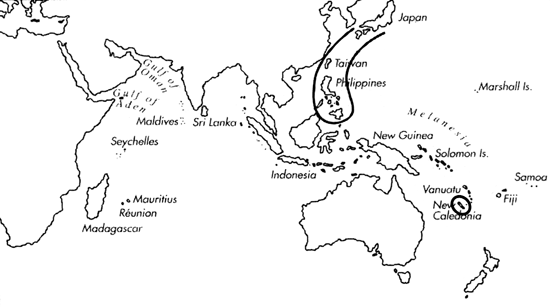Range: Japan to Philippines; Loyalty Is.
Description: Medium-sized to moderately large, moderately solid to solid. Last whorl conical to ventricosely conical or conoid- cylindrical; outline somewhat convex at adapical third, straight below. Shoulder angulate to subangulate. Spire of low to moderate height, outline deeply concave to slightly sigmoid. Larval shell of more than 3 whorls, maximum diameter about 0.9 mm. First 6-8 postnuclear whorls tuberculate. Teleoconch sutural ramps flat, with 1 increasing to 3-4 spiral grooves. Last whorl with spiral ribbons from base to shoulder; toward base, posterior edge of ribbons more prominent and often weakly granulose.
| Shell Morphometry | ||
|---|---|---|
| L | 41-66 mm | |
| RW | 0.19-0.48 g/mm | |
| RD | 0.50-0.56 | |
| PMD | 0.82-0.87 | |
| RSH | 0.07-0.18 | |
Ground colour white. Last whorl with light brown to violet brown clouds, forming an interrupted spiral band on each side of centre, and a less prominent band below shoulder; with narrow, wavy brown or reddish brown axial lines from base to shoulder, extending across the shoulder ramp. Larval whorls white. About first 5 postnuclear sutural ramps immaculate; following sutural ramps with brown to reddish brown radial lines often underlain by paler brown radial blotches. Aperture white.
Habitat and Habits: In 100-390 m.
Discussion: C. kuroharai is similar to C. armadillo and C. australis. C. armadillo differs in its ventricose last whorl (PMD 0.77-0.84) with more convex sides, its generally higher spire (RSH 0.15-0.23), and in its last whorl pattern of spiral rows of short, simple to furcate axial dashes, mainly on spiral ribbons. C. australis is larger and lacks continuous axial lines as the predominant pattern of C. kuroharai. C. australis australis has a more elongate last whorl (RD 0.44-0.52) and a different spiral sculpture of narrow, variably granulose ribs. C. australis gabryae differs also in its more ovate last whorl (PMD 0.72-0.80) with more convex sides.

C. kuroharai range map
This section contains verbatim reproductions of the accounts of 316 species of Conus from the Indo-Pacific region, from Manual of the Living Conidae, by Röckel, Korn and Kohn (1995). They are reproduced with the kind permission of the present publisher, Conchbooks.
All plates and figures referred to in the text are also in Röckel, Korn & Kohn, 1995. Manual of the Living Conidae Vol. 1: Indo-Pacific Region.
The range maps have been modified so that each species account has it own map, rather than one map that showed the ranges of several species in the original work. This was necessary because each species account is on a separate page on the website and not confined to the order of accounts in the book.